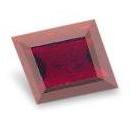|
|
|
|
Click on a letter above to view the list of gems. |
|
|
|
|
|
Staurolite |
|
| Chemistry:
(Fe2+;Mg)2Al9(Si;Al)4O20(O;OH)4 | |
| Discovered
in 1792;
IMA
status: Valid (pre-IMA; Grandfathered). | ||
|
| ||
|
Classification |
|
|
| |
|
Silicates | |
|
8/B.03-10 | |
|
|
9 : SILICATES (Germanates) |
|
Related to: |
Staurolite Group. Staurolite - Gerstmannite Series |
|
|
|
|
Crystal Data |
|
|
|
|
|
Commonly in prismatic crystals, typically rough, to 12 cm. |
|
|
Commonly as 60º twins with [231] as twin plane, may be cyclic; less commonly as 90º cruciform twins with [031] as twin plane. |
|
|
|
|
|
Physical Properties |
|
|
|
|
|
[010] Distinct |
|
|
Conchoidal |
|
|
Brittle |
|
|
7.0 - 7.5 |
|
|
3.74 - 3.83 (g/cm3) |
|
|
None |
|
|
Not Radioactive |
|
|
|
|
|
Optical Properties |
|
|
|
|
|
Dark Reddish Brown to Blackish Brown, Yellowish Brown, rarely Blue |
|
|
Transparent to Opaque |
|
|
Sub-Vitreous to Resinous |
|
|
1.736 - 1.762 Biaxial ( + ) |
|
|
0.0090 - 0.0150 |
|
|
Weak; r > v |
|
|
Visible; X = colorless, Y = pale yellow, Z = golden yellow |
|
|
|
|
|
Occurances |
|
|
|
|
|
Geological Setting: |
Common in pelitic schists, gneisses, and argillaceous rocks regionally metamorphosed to amphibolite grade; also a detrital mineral. |
|
Common Associations: |
Almandine, Chloritoid, Kyanite, Muscovite, Quartz, Sillimanite, Tourmaline |
|
Common Impurities: |
Ti, Cr, Mn, Co, Zn, Li, H2O |
|
Type Locality: |
n/a |
|
Year Discovered: |
1792 |
|
View mineral photos: | |
|
|
|
|
More Information |
|
|
|
|
|
| |
|
|
|
|
Most facetable material comes from
Ardenella and Rubellita, Minas Gerais, Brazil; Liaoning Province, China;
and Pizzo Forno and Alpe Piona, Ticino, Switzerland.
|
|
|
We
have not photographed our Staurolite
gems. Please
check back soon. |
